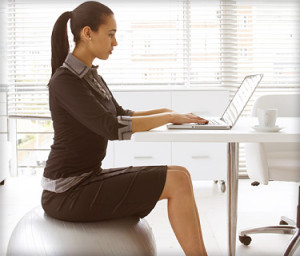These days, it seems like everyone is working more hours and using the old “no-time-to-exercise” excuse, more and more. But what if you could actually work out at your desk, or even while taking a driver’s safety class from iDefensiveDriving.com?
While you won’t get into the Olympics this way, you can do stretching, muscle-strengthening, and even short stints of aerobic exercises right at your desk and around your office. After all, doctors say that any amount of exercise helps… and the benefits are cumulative!
Here are a few suggestions for working out at your desk, and around your office from iDefensiveDriving.com:
Use an exercise or balance ball as your desk chair
- Sit up straight on the ball with your legs out in front of you, and your feet firmly on the floor. At first, you can place your calves so that they are touching the ball. This will give you added stability, while learning to use the ball. Later, you will want to move your calves, so they are not touching the ball, which will provide more benefits for your core.
- Bend your elbows and place your forearms at a 90 degree angle. While reaching forward slightly, you should be able to rest your forearms on the top of the desk or table. If you are using a computer, make sure it is at a 90 degree angle. If it is not, your neck will be out of alignment with the rest of your spine, and the ball will be less useful in helping to improve your posture.
- Practice active sitting. This is the state when your body reacts to the prospect of falling off the ball by tightening your core muscles in your stomach and back. Flex the muscles in your abdomen to add an extra element of exercise. Hold the flex for 30 seconds and release. As you become more adept, practice slowly rocking your hips and abdomen backward and forward, side to side, and in small circular motions.
- Use the ball in 10-20 minute intervals. Do not get rid of your office chair. Just like exercise, it is important to give your muscles rest to prevent muscle fatigue, and to receive the maximum benefit.
- Work up to 30 minute intervals as you get used to the chair. Doctors do not recommend that you sit for longer than 30 minutes at a time.
Walk it out
- Whenever you get up to change chairs, take a brief walk around the office to stretch your legs, abdomen, and lower back. Loosen up your neck, arms and shoulders by doing arm and neck rotations.
- If available, walk an occasional flight or two of stairs. Walking stairs provides an efficient low-impact cardiovascular workout that also builds strength in your lower body. The vertical nature of stairs presents a unique challenge for the quadriceps, hamstrings and glutes. Most exercise and athletic activity consists of moving forward or laterally, such as jogging, walking and cycling. Whereas the upward motion used to climb stairs requires your body to move in an alternative direction. Working your muscles from different angles can help you to maximize muscle growth, burn more calories and improve your overall health.
This has been another weekly update from iDefensiveDriving.com. We look forward to seeing you driving “safely” in Texas.


